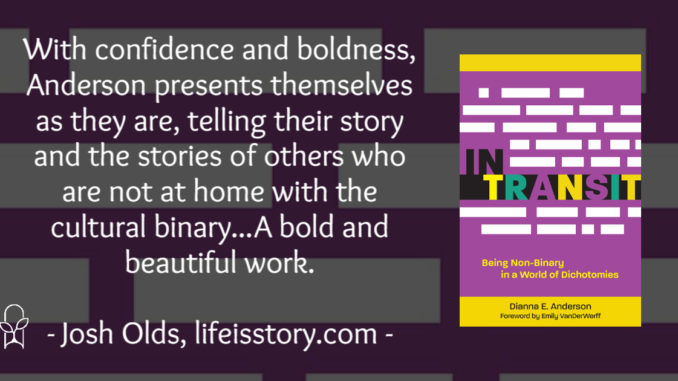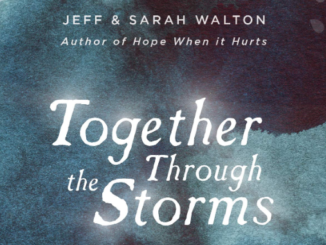
Published by Broadleaf Books on July 12, 2022
Genres: LGBTQ+, Non-Fiction, Memoir
Buy on Amazon
Goodreads

For decades, our cultural discourse around trans and gender-diverse people has been viewed through a medical lens, through diagnoses and symptoms set down in books by cisgender doctors, or through a political lens, through dangerous caricatures invented by politicians clinging to power. But those who claim non-binary gender identity deserve their own discourse, born out of the work of the transsexual movement, absorbed into the idea of transgender, and now, finally, emerging as its own category.
In tracing the history and theory of non-binary identity, and telling of their own coming out, non-binary writer Dianna E. Anderson answers questions about what being non-binary might mean, but also where non-binary people fit in the trans and queer communities. They offer a space for people to know, explore, and understand themselves in the context of a centuries-old understanding of gender nonconformity and to see beyond the strict roles our society has for men and women.
In Transit looks forward to a world where being who we are, whatever that looks like, isn't met with tension and long-winded explanations, but rather with acceptance and love. Being non-binary is about finding home in the in-between places.
On the back cover of In Transit: Being Non-Binary in a World of Dichotomies, the book lists its Library of Congress categorization: Social Science / LGBT Studies / Transgender Studies. In the conversation about gender, non-binary identities get wrapped up into final letter of the acronym. When you think about it, transgender is already the outlier in the acronym. It’s a term denoting gender, while the other three terms denote sexual orientation. The non-binary experience is a very small subset within the transgender experience. Most conversations about transgender identity involves moving from one pole of the binary to the other—from male to female or female to male. But what of those in-between? What of those In Transit? Non-binary individuals often find themselves marginalized and erased—even from within their own categorization. In Transit, written by non-binary author Dianna E. Anderson, brings the non-binary experience into the spotlight and offers readers a thorough, clear, and personal look into non-binary gender identity and expression.
In Transit is able to offer readers both personal and professional perspectives. Is the book well-written? The author has a master’s degree in English. Are they able to write accessibly for an audience coming from an American Christian culture. The university they graduated from was Baylor University. Do they have the professional expertise to make this more than a memoir? They also have a master’s in women’s studies from Oxford. Do they have a personal connection? They are non-binary themselves. The end result is that In Transit is able to demystify the non-binary experience while retaining its mysticism. That is, while Anderson is able to talk professionally about the panoply of gender-diverse expressions, define terms, and discuss history, they are also able to talk about the individual nature of gender expression using their own experience. In Transit isn’t just a book about the whole or just a book about the individual, Anderson is able to encapsulate both—encouraging readers to embrace the fluidity.
The first half of the book builds the foundation for discussing non-binary gender identity. Chapter one is about finding the right words to use when having the discussion—even helpfully providing a glossary for those who may be unfamiliar with some of the established terms—and talking about the harm done when insensitive or derogatory language is used. Chapter two is a history of non-binary identity. One of the arguments I often hear in conservative circles is “back in my day…” Well, In Transit convincingly shows that back in everyone’s day, gender-diverse people have existed and that understanding gender diversity in the past helps inform our understanding in the present. The third chapter goes further specifically into non-binary identity and its emergence as part of, then out from, transgender identity.
The second half of the book moves into specifics of non-binary expression, discussing how non-binary individuals often feel left out and unsure of their place in a world seeking rigid boxes and precise definitions. At one point, Anderson writes that they have “developed a sense of myself that is more at home to me as non-binary than womanhood ever was. I am in transit.”
The book’s final chapter is written specifically to allies—to cisgender readers—to recognize deep-seated bigotry and bias and lean new patterns of thinking. Anderson offers six suggestions:
- Question yourself. Understand why you believe yourself to hold to a certain gender expression. What makes you the gender you are?
- Respect the labels. It’s basic respect.
- Don’t make us manage your feelings. Do your best to speak respectfully and accurately, but if you mess up, just correct yourself and move on. Practice using appropriate pronouns.
- Don’t be so serious.
- Ask questions within appropriate boundaries.
- Let us be vulnerable.
This is a lot to fit in one chapter and I would love to see a future book expand this out. Anderson doesn’t owe allies a course on how to be good humans toward non-binary people, of course, but their voice in In Transit is careful, precise, and compassionate. I’d love to learn more from them.
In Transit is a powerful and necessary proclamation of being. With confidence and boldness, Anderson presents themselves as they are, telling their story and the stories of others who are not at home with the cultural binary. For some, this book will be a foundation for understanding the non-binary experience as allies and is thus crucial for teachers, pastors, coaches, and leaders of all sorts to read and soak in. For others, this will be the book that help them find a home and gives a defined space where they fit. I firmly believe that In Transit will save lives because of this. It’s a bold and beautiful book.



